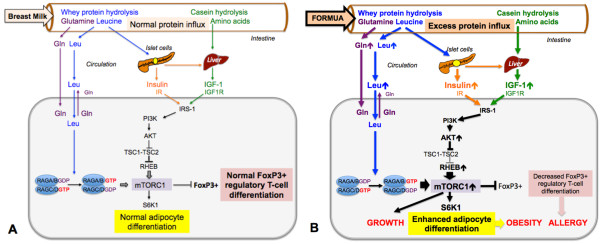Figure 2.

Comparison of breast milk- and formula-mediated mTORC1 signalling. A. Human breast milk guarantees the appropriate intestinal influx of milk proteins that after hydrolysis release leucine (Leu) and glutamine (Gln) into the circulation. Whey-derived leucine stimulates insulin secretion, whereas casein-derived amino acids stimulate hepatic IGF-1 synthesis. Insulin and IGF-1 via PI3K activate AKT that attenuates the inhibitory activity of the tuberin complex (TSC1-TSC2) towards RHEB, the GTPase that finally acivates mTORC1. Glutamine enhances cellular leucine uptake that activates the RAG GTPases, the essential step for mTORC1 activation at the lysosomal surface. Physiological mTORC1 activation results in normal activation of the kinase S6K1 that controls adipocyte differentiation and adequate expression of FoxP3+ regulatory T-cells. B. Excess protein uptake by infant formula feeding enhances plasma levels of leucine, insulin and IGF-1 overactivating mTORC1. Overstimulated S6K1 enhances adipocyte differentiation and inhibits FoxP3 expression, thus promotes growth, obesity and allergy development. Abbreviations: IR: Insulin receptor; IGF-1 insulin-like growth factor-1; IGF1R: IGF-1 receptor; IRS-1: Insulin receptor substrate-1; PI3K: Phosphoinositiol-3 kinase; AKT: Akt kinase (protein kinase B); TSC1: Hamartin; TSC2: Tuberin; RHEB: RAS-homolog enriched in brain; RAG: RAS-related GTP-binding protein; S6K1: Ribosomal protein S6 kinase, 70-KD.
